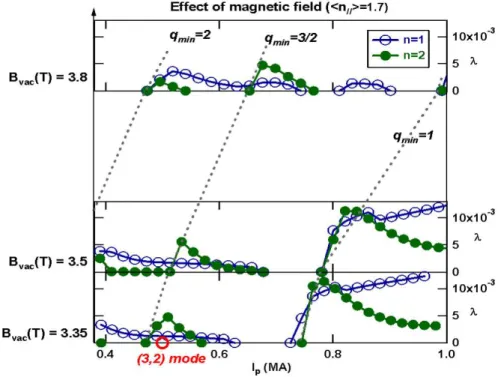HAL Id: hal-00002035
https://hal.archives-ouvertes.fr/hal-00002035
Preprint submitted on 21 Oct 2004HAL is a multi-disciplinary open access
archive for the deposit and dissemination of sci-entific research documents, whether they are pub-lished or not. The documents may come from teaching and research institutions in France or abroad, or from public or private research centers.
L’archive ouverte pluridisciplinaire HAL, est destinée au dépôt et à la diffusion de documents scientifiques de niveau recherche, publiés ou non, émanant des établissements d’enseignement et de recherche français ou étrangers, des laboratoires publics ou privés.
MHD stability of fully non inductive discharges in Tore
Supra
P. Maget, Frédéric Imbeaux, G. Huysmans, Ph. Moreau, M. Ottaviani, J.-L.
Segui
To cite this version:
P. Maget, Frédéric Imbeaux, G. Huysmans, Ph. Moreau, M. Ottaviani, et al.. MHD stability of fully non inductive discharges in Tore Supra. 2004. �hal-00002035�
MHD stability of fully non-inductive discharges in TORE SUPRA
by P. Maget, F. Imbeaux, G. Huysmans, Ph. Moreau, M. Ottaviani, J.-L. Segui
Association Euratom-CEA, CEA Cadarache, F-13108 Saint-Paul-lez-Durance, France
Fully non-inductive discharges are performed on the Tore Supra tokamak using Lower Hybrid (LH) waves in a current drive scheme. The MHD aspect is a crucial issue for these discharges, since after hitting an MHD limit it may run into a regime where a strong permanent MHD activity develops. This so-called MHD regime [Maget04] degrades fast electron confinement as well as LHCD efficiency and electron confinement in the plasma core. In the 2003 campaign, a milestone has been reached with the injection of more than 1 GJ of energy in the tokamak, in stationary discharges lasting more than 6 minutes. But the MHD regime has been encountered in several discharges, while the record discharges have shown a very stationary (m=3, n=2) MHD activity in the plasma core without triggering the MHD regime (see figure 1).
With the exploration of several global parameters such as the toroidal magnetic field (B), the parallel refractive index of LH waves (n//) and the total plasma current (Ip), a map of MHD
properties for fully non-inductive discharges has been drawn. This is achieved by extrapolating in Ip reference magnetic equilibriums from stationary pulses, while imposing a
constant shape of pressure and current profiles, and a poloidal beta βp~1/Ip. Note that in the
experimental conditions explored, the LH deposition profile is globally peaked, but hollow in the very core, and the region of reversed magnetic shear extends while n// increases.
Linear stability properties are investigated with the CASTOR code [Kerner89], which gives the linear growth rate of resistive MHD modes in toroidal geometry. They show the existence of stable domains for qmin>2 and for 1.5>qmin>1, in agreement with the analysis of
past experiments [Wijnands94, Litaudon96, Zabiego01]. But most of the explored domain is MHD unstable, including the point where the record pulses have been performed with a remarkable reliability (see figure 2). Saturated tearing modes are indeed observed in several cases without triggering the deleterious MHD regime.
Considering the non-linear evolution of MHD modes is necessary for discrimination between harmless saturated modes and the MHD regime. A particular pulse where a slow ramp down of the total plasma current was performed up to the triggering of the MHD regime allows to identify the mechanism of transition. It can be attributed to the full reconnection of the double tearing mode, which flattens the electron temperature profile up to the outer resonant surface. Its condition of occurrence can be estimated from the calculation of the helical flux relative to the resonant surface q=m/n: ψ* =
∫
dψ(
m/n−q)
. The full reconnection happens when ψ* is close to zero at the outer resonant surface [Carreras79]. The domain where the MHD regime can be triggered is therefore approximately given by the condition m/n>qmin>q(ψouter* =0). Such an evaluation is consistent with the experimentalpoints where the MHD regime is indeed triggered (see figure 3), although a safe interval exists for qmin slightly below a rational (as for record pulses), while full reconnection occurs
for ψouter* slightly above zero, in agreement with non-linear MHD simulations. Note that the regime where full reconnection is observed is tearing-like, scaling with resistivity as η3/5, and is consistent with the 'intermediate regime' described by Ishii et al [Ishii00].
As a result, a map of MHD properties for fully non-inductive discharges is established, which can be used for the design of future experiments. For longer-term purpose, the drawing of such a map could be implemented in a real-time module for self-programmed discharges, which could avoid deleterious MHD activity while optimizing the discharge performance.
References:
[Maget04] Maget P. et al 2004 Nucl. Fusion 44 443 [Kerner89] Kerner W. et al 1989 J. Comput. Phys. 85 1 [Wijnands94] Wijnands T. et al 1994 Nucl. Fusion 37 777
[Litaudon96] Litaudon X. et al 1996 Plasma Phys. Control. Fusion 38 1603 [Zabiego01] Zabiego M. et al 2001 Nucl. Fusion 43 1625
[Carreras79] Carreras B. et al 1979 Nucl. Fusion 19 583 [Ishii00] Ishii Y. et al 2000 Phys. Plasmas 7 4477
Figures: -0.05 0.00 0.05 δT(keV) 2.8 2.6 2.4 2.2 2.0 R (m) TS 31538 t = 100 sec. magnetic axis
Figure 1: Radial structure of electron temperature fluctuations after 100 seconds of plasma for pulse TS-31538
Figure 2: Linear growth rate (λ=γτA) of n=1 and n=2 resistive MHD modes, as a function of
fields. At B=3.35T is indicated the position where record pulses have been performed, with the observation of a very stationary (m=3,n=2) mode.
3.8 3.7 3.6 3.5 3.4 B (T) 0.7 0.6 0.5 0.4 Ip (MA) Explored (no MHD regime) MHD regime Triggering region qmin=2 ψψψψ*q=2=0 qmin=3/2 ψψψψ* q=3/2=0 MHD regime triggering (n//=1.7) Record pulses
Figure 3: Domain (B, Ip) where MHD regime can be triggered, for n//=1.7. Explored regions
and observed transitions are indicated. Frontiers of rational qmin and ψouter* =0 are obtained
from reference pulses. The triggering region is in fact for qmin slighly below a rational (as for
record pulses), down to a q-profile where ψ* is slighly above zero at the outer resonant surface.

